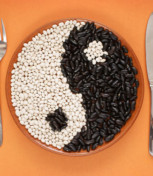
Take time to smell the . . . onions?
Sheila Brown CCO Public Domain
Crossing Cultures: Peeling the Layers of a Truly Global Food
Quick—what food is a staple of every global cuisine?
Wheat? Nope. Rice? Guess again. Uh, potatoes? B-z-z-z! Game over!
It’s the onion.

Americans eat 22 lbs. of onions per person per year, placing 5th after Libya (66 lbs).
© Joyce McGreevy
It’s grown in over 175 countries—twice as many as wheat, according to United Nations estimates. The UN Food and Agriculture Organization lists China as the world’s largest producer of onions, followed by India, the United States, Turkey, and Pakistan.
Oh, I see: The vegetable that makes eyes water also makes mouths water across cultures.
Put on your goggles as we peel away the layers to see why onions are the apple of every culture’s eye.
Older Than Thyme?
Onions have been cropping up in recipes for more than 5,000 years. Originating between present-day Iran and Pakistan, they could be grown in all kinds of soil and stored for long periods. As a result, onion farming spread quickly around the world.
How quickly? So quickly that when European explorers ‘”introduced” onions to the Americas, they discovered that onions were already there.

Chicago’s name derives from a Native American word for wild onions that grew along its river.
Image by bk_advtravir/Pixabay
Nature’s Ninja
Experts recently declared onions “nutritional powerhouses,” but many world cultures have known that for thousands of years. Egypt’s pyramid builders ate them every day. So did the armies of Alexander the Great.
Onions also crossed cultures as an early form of medicine. From ancient Rome to early India, onions became a cure-all for everything from blisters to battle wounds.
According to Dioscorides, a first-century Greek physician, Olympian athletes fortified themselves by eating onions, drinking onion juice, and rubbing onions all over their bodies. That’s one way to keep the competition—and everyone else—at bay.

A fresco from Pompeii reflects onions’ prominence in Roman cuisine.
[public domain]

In 1887, onions and cabbages inspired this now-faded still life by Vincent van Gogh.
Van Gogh Museum, Amsterdam (Vincent van Gogh Foundation) [public domain]
Speaking of Onions
Onions have rooted themselves across cultures, sometimes in surprising ways. Take food idioms, for instance:
- In Britain, “You know your onions” praises someone’s expertise.
- But in France, S’occupe-toi tes oignons (“Take care of your onions”) means “Mind your own business!”
- And in Iran, Mam na sar-e piâzam na tah-e piâz (“I’m neither the top nor the bottom of the onion”) means “It doesn’t concern me at all!”

Can onions predict weather? An old English rhyme says yes: “Onion skins very thin,
/Mild winter coming in./Onion skins very tough,/ Coming winter very rough.”
The Global Prime Ingredient
Today, most world cuisines are built on a base of onions. Several countries feature their own distinctive version of a “culinary trinity”—a three-ingredient combination used to establish a culture’s signature flavor. Now check out the common denominator:
- Italian Battuto: onion, garlic, parsley
- Lousiana Cajun base: onions, bell peppers, and celery
- Spain’s Sofrito: onions, tomatoes, garlic
- Portugal’s Refogado: onions, peppers, tomatoes
- Hungary’s top trio: onion, paprika, lard
- India’s top trio: onion, garlic, ginger
- West Africa’s top trio: onions, chili peppers, tomatoes
- Chinese Xiang Cong base: green onions, ginger, garlic
- French Mirepoix: onions, carrots, celery

It’s my mire-poix and I’ll cry if I want to! But tear-free options are easy to find.
© Joyce McGreevy
A Gallivanting Globe
For travelers who love to cook, onions at farmers markets offer the affordable pleasure of broadening one’s palate.

Shop Copenhagen’s Torvehallerne market to cook Denmark’s famous
Bløde Løg, pan-fried onions.
© Joyce McGreevy
From the Tokyo Long White to the golden German Stuttgart to India’s rosy Arka Bindhu, onions are edible globes that embody global cuisine’s variety.
In Italy, cipolline, flat purple or white onions have a surprisingly buttery taste brought out by simmering or roasting. Cook them low and slow with a dash of espresso and a splash of Montepulciano to make rich gravy for an Italian-style pot roast.

The Allium family includes the onion’s wild cousin, ramps (above), scallions, shallots, garlic,
leeks, and chives.
© Joyce McGreevy
In France, “gray” shallots, (échalotes grises/griselles) are more colorful than their name suggests. Count on them to add complexity to a creamy vinaigrette.
North American farmers markets are also rich in choices: New York’s potent “Black Dirt” onions, Texan and Georgian Vidalias, Washington’s Walla Walla and Siskiyou, Hawaii’s Maui onions.
Why Did the Onion Cross the Road?
For sheer global expansiveness, there’s the Egyptian Walking Onion, also known as the Welsh Onion, native to India or Pakistan, and introduced to Europe by the Romans. It’s also the world’s most unusual onion: Bulbs grow up top like fruit on a tree and then topple over, causing new plants to grow—hence the effect of “walking” across a field.

These are onions? Edible chive blossoms show onions’ more delicate side.
© Joyce McGreevy
A Multi-Layered Experience
Whether you chew it or eschew it, the humble onion has moved across cultures and earned worldwide recognition. It has even moved in and out of the food scene, obsessed over by ancient Mesopotamian cooks, used as European currency, and made into eco-friendly dyes in many countries.
In India, this staple of global cuisine has affected economic policy. In the U.S., onions figured into federal law—after two rapscallions cornered the onion market, causing a nationwide stink. Just listen to the wild, true “Tale of the Onion King” and you’ll really know your onions.
In short, the onion dips into history, runs rings around other veggies, and really stands up to a grilling.

In Comacchio, Italy, onions add bite to a slice. How do you like onions?
© Joyce McGreevy
Ready to peel some onions? Our downloadable PDF offers a world tour of recipe ideas for using this most versatile vegetable.
Comment on the post below.






















I love this article! From the rich and interesting history to onion skins predicting weather…! I will now truly appreciate this versatile and savory wonder. Oh, and I especially liked the global culinary trinity!
I am so in the mood to cook!!
Thank you for that lovely comment, Erin! Sometimes when I’m not sure what to cook for dinner I just start sautéeing onions, knowing that the sizzle and the savory aroma will trigger ideas. Speaking of ideas, enjoy our free PDF, “Round the World in 14 Tasty Onion Recipes” at the end of the post. Happy Thanksgiving—and may the onions be with you!
Oh wow Joyce . I love my onions. Loved this article. Look at you girl! Happy Thanksgiving to you and yours.
Aw, thank you, Mary! See you in Ireland this summer? Oh, and to share the free recipe booklet with friends, just forward or re-post the article. xoxo
Yummy article! And so colorful. I’m off to cook up some scrambled eggs with, well, you can guess…
Thanks, Rick! I love that combination. Check out our link to Bløde Løg (Danish pan-fried onions) for an easy way to make an amazing savory topping. Happy Thanksgiving!